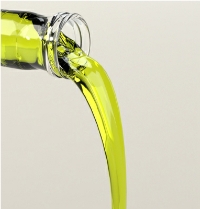
I want to concentrate on just a couple of foods here, olive oil and apple cider vinegar.
Both these foods have been shown to aid in weight loss, and if you have less excess fat to carry around the track, you’ll run faster. I’m not suggesting that if you pop into the kitchen and swig on the salad dressing like there’s no tomorrow, you’ll wake up a couple of kilos lighter in the morning, but research has shown both these foods may aid weight loss.
So, how can olive oil help you run faster?
Research published in the American Journal of Nutrition has suggested that simply smelling olive oil may help you lose weight. Eleven men were given low fat yoghurt to eat over two days, and half of them had a fat free olive oil extract mixed into the yoghurt.
Their brain activity was measured after the snack, and the group who ate the olive oil extract enriched yoghurt, had increased activity in areas of the brain associated with fat consumption. Remember the olive oil extract was fat-free, so both groups had the same low fat snack as far as calories go. Researches believe it is the scent of the olive oil which might help you to feel full. It might be possible to simulate fat-triggered sensations in the brain by the scent of ingredients the body implicitly associates with fat.
Other research carried out over a period of three months supports this theory. Subjects ate no-fat yoghurt, with either butterfat, rapseed oil or olive oil added to it. The olive oil consumers reported feeling fuller on a day to day basis, and also had higher levels of serotonin than the other groups. Serotonin is a hormone associated with feelings of satiety. The aromatic compounds in olive oil slow the absorption of glucose into the blood stream, making as feel fuller for longer.
To enjoy the benefits of olive oil, you should consume in moderation at room temperature, accompanying other food. Whilst olive oil is relatively stable, overheating it can change the molecular structure and the aromatic volatiles can evaporate during heating.
Apple cider vinegar
The Journal of Functional Foods recently published a study showing that subjects who consumed a tablespoon of apple cider vinegar mixed with water before eating had lower blood glucose levels than the control group. The acetic acid may hamper the body’s ability to digest starch, the researchers say. Less starch is being broken down into calories in the blood stream, which over time might show an effect on body weight. There are other studies to back up the theory, including Japanese research published in 2009, which showed acetic acid to be associated with lower BMI, waist circumference and blood triglycerides.
You don’t need to use apple cider vinegar for the effect. Any vinegar with 5% acidity will do, but don’t drink it straight. Mix a tablespoon with a big glass of water, or drizzle the same amount on a salad.
Neither of these methods will see you losing 5kgs to get you running faster in that race you have next weekend. You should be looking more at the long term over 3 or 4 months. AND most importantly, the results won’t be so dramatic that you can go crazy and eat your head off in the meantime. Increasing your use of olive oil and vinegar will not counteract your over eating, but may be the difference between losing that extra half to one kilo or not.
To some, it may not seem worth it, but I know I’d like to be a kilo lighter come the next time I run a race I’ve been training for.
Image courtesy of Idea go/freedigitalphotos.net



 A while ago now I wrote a post entitle
A while ago now I wrote a post entitle 


